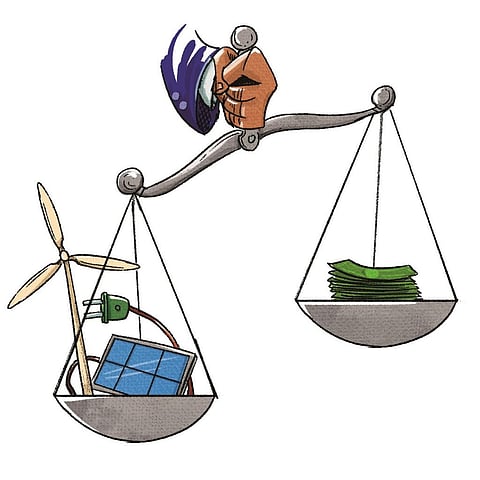Getting out of fossils
Why differentiate between coal and natural gas, when both are fossil fuels? I had asked this last fortnight, as it is a question of climate justice and most importantly, the feasibility of moving at speed and scale to reduce fossil fuel emissions responsible for heating up the Planet.
The fact is, roughly 70 per cent of the world’s population have not contributed to the stock of emissions in the atmosphere but are today highly dependent on coal for energy.
Richer countries have made the transition from coal to natural gas, which is somewhat cleaner—it emits roughly half the carbon dioxide emitted by coal, in addition to methane. But given their enormous appetite for energy, these countries’ past and current emissions are high; totally disproportionate to their share of global carbon budget.
Now, the burden of transition to clean energy has been shifted to countries that are least responsible for the stock of emissions and least capable of making the switch. This is not only unjust but also unrealistic. It makes the fight against climate change even more intractable and difficult.
The current global efforts are twofold. One, to stop financing coal-based thermal power projects in countries of the South. Two, to provide funding to close down coal thermal plants and to make the switch to renewable power.
The Just Energy Transition Partnership (JET-P) of the G7 countries now includes South Africa, Indonesia and Vietnam. The jury is still out on whether JET-P will provide the enabling funds for the scale of the transition.
The cost of building new renewable power projects is still two to three times that of a new coal-based project in spite of the reducing costs of solar and wind energy. So, unless finances are proportionate to the need, transition to clean energy is a tough proposition, especially in countries where affordability of energy is critical.
What, then, are the options ahead? Let me discuss this in the context of India, where we need to address the issue of toxic air pollution because of coal burning.
We cannot become defenders of coal however bad global politics may be. It is in our interest to reduce local air pollution and to combat climate change. But we need to do this based on our imperatives.
The strategy should be to vastly increase the rates of electrification in the country so that we can reduce coal combustion in millions of industrial boilers that are inefficient and highly polluting, and to move towards electrification of vehicles, which in turn will reduce air pollution in our cities.
The zillion-dollar question then is, how will this electricity be produced? This is where we should engage with JET-P. Our first task is to reduce dependence on coal even as we vastly increase our energy supply. This means doing more of what the Indian government is also committed to doing; limiting coal and investing in cleaner natural gas and renewable energy.
Reducing India’s coal power dependence in the electricity mix to 50 per cent from over 70 per cent now, would mean upping our target for renewable energy from 450 GW to 650-700 GW by 2030.
This scale of transformation will need financing, especially if we want to keep the cost of new renewable energy capacity low so that energy is affordable. This is where international partnerships must be sought; both to reduce the cost of finances and to provide additional finance. This should be the focus of JET-P; to quickly ramp up cheaper finance so that the new energy future is clean.
The question that remains is what do we do with the existing coal plants? We should “clean” these plants; there should be no further procrastination about enforcing the 2015 new emission standards notification of the Union Ministry of Environment, Forest and Climate Change.
This will reduce local air pollution from existing power plants. We should also push towards natural gas-powered plants—India has stranded assets of 20 GW that need to be fired up. For this, we need natural gas at affordable rates and this should be our ask.
In addition, examine what can be better done to this existing coal fleet to make it climate-smart. The older generation plants that cannot be refurbished need to be phased out; but this needs a plan so that labour and land assets can be redeployed for clean energy generation. This should be a package deal with clear milestones for emission reduction and energy access.
The global community needs to rework its proposals.
First, JET-P needs to be an enabler for clean energy transition; instead of being the stick on coal, it must become the carrot for the new infrastructure to be clean and climate-smart. This means focusing on making the cost of finances to the emerging world, which is 2-6x higher than the developed OECD countries, much lower and more accessible.
Second, the global energy transition pathway has to be for all fossil fuels—coal and natural gas. This would not only show that richer countries have exhausted their quota for using natural gas, but also make gas available at affordable costs to emerging countries that face the twin problems of local and global emissions.
Let’s be clear, the science of climate change is also the politics of inclusion and responsibility. This is where we must get it right.


